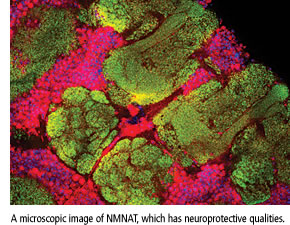 The mechanisms responsible for the cell damage that leads to degenerative diseases like Huntington’s disease, spinocerebellar ataxia, and Alzheimer’s disease remain largely a mystery to scientists. The mechanisms responsible for the cell damage that leads to degenerative diseases like Huntington’s disease, spinocerebellar ataxia, and Alzheimer’s disease remain largely a mystery to scientists.
But a new discovery made by a team of scientists led by Grace Zhai, Ph.D., assistant professor of molecular and cellular pharmacology at the Miller School, and Hugo Bellen, Ph.D., a Howard Hughes Medical Institute investigator at Baylor College of Medicine, has revealed a protective factor against neurodegenerative conditions that advances research in the field.
The study, published in the prestigious scientific journal Nature, establishes the neuroprotective qualities of the protein NMNAT. Using the fruit fly Drosophila as a model to study degeneration and protection, Zhai and her team determined that NMNAT plays an important role in maintaining the integrity of nerve cells. This is the first time that an additional neuronal function of this protein has been identified. (See story on page 11 on Zhai’s fruit fly research.)
“We speculate that the mechanisms we discovered in Drosophila model systems are conserved in the mammalian nervous system,” says Zhai. “More important, our studies suggest that understanding the mechanisms of neuronal maintenance will be essential to uncovering ways to protect neurons from several neurodegenerative conditions.”
NMNAT (nicotinamide mononucleotide adenylyltransferase) is a “housekeeping” enzyme known to be essential for synthesizing NAD, an enzyme co-factor fundamental for normal cell metabolism. NMNAT also protects nerve cells from degeneration by acting as a “chaperone,” a molecule that protects proteins from unfolding and helps misfolded proteins to refold, says Zhai. “Interestingly, by increasing the NMNAT protein level in neurons, we can increase the ability of neurons to tolerate disease-inducing environmental stress.”
The findings may have implications for the prevention and treatment of degenerative conditions caused by protein misfolding, which include Huntington’s disease, spinocerebellar ataxia, and some forms of Alzheimer’s disease. |


